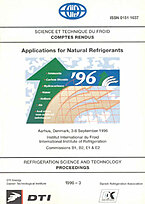
IIR document
Design aspects and applications of resorption cycles.
Author(s) : HEWITT N. J., MCMULLAN J. T., MOLYNEAUX G.
Summary
The ammonia-water or resorption cycle is similar to the conventional absorption cycle in the fact that both absorption and desorption do take place, but in this case, their roles are reversed, i.e. absorption takes place on the high temperature side and desorption takes place on the low temperature side. In both cases, the absorption/resorption process alters the composition of the liquid and consequently, at a constant pressure, the temperature changes or "glides". The resorption cycle is a hybrid absorption-vapour compression system which has been shown to be capable of high temperature applications and high temperature lifts when using an ammonia-water mixture. The paper highlights the areas in which the operation of a high temperature heat pump of this type would be beneficial. Secondly, the design procedures are demonstrated for this type of cycle. Additionally, the use of log mean temperature difference as a heat exchanger design tool has been studied. Finally, compressor and lubricant selection are seen to be problematical. Oil free-screw compressors would alleviate (at least in part) the oil problems associated with these types of cycles.
Available documents
Format PDF
Pages: p 347-354
Available
Public price
20 €
Member price*
Free
* Best rate depending on membership category (see the detailed benefits of individual and corporate memberships).
Details
- Original title: Design aspects and applications of resorption cycles.
- Record ID : 1997-3020
- Languages: English
- Source: Applications for Natural Refrigerants
- Publication date: 1996/09/03
Links
See other articles from the proceedings (88)
See the conference proceedings
Indexing
- Themes: Heat pumps techniques
- Keywords: Design; Resorption; Heat recovery; Ammonia-water; Absorption system; Compression system; Heat pump; Heat exchanger; Compressor
-
Schemes and cycles of the water-ammonia compres...
- Author(s) : MOROSUK T. V., MOROSUK L. I., BAGNAN D.
- Date : 1996/09/22
- Languages : English
- Source: Heat pumping technologies towards the next century: applications and markets. Proceedings of the 5th IEA Conference.
View record
-
COMPRESSION-ABSORPTION HEAT PUMPS.
- Author(s) : AHLBY L., HODGETT D. L.
- Date : 1990/03/12
- Languages : English
View record
-
Performance analysis of a vapour compression he...
- Author(s) : JEONG S., YUN H. G., PARK K., et al.
- Date : 2009/03/19
- Languages : Korean
- Source: The 3rd Korean Congress of Refrigeration.
View record
-
Thermodynamic analysis of a wet compression hyb...
- Author(s) : ITARD L. C. M., MACHIELSEN C. H. M.
- Date : 1992/09/07
- Languages : English
- Source: Proposals for the generation and use of refrigeration in the 21st century.
- Formats : PDF
View record
-
A NEW ABSORPTION HEAT PUMP FOR SPACEHEATING.
- Author(s) : BASSOLS J.
- Date : 1990/03/12
- Languages : English
View record
